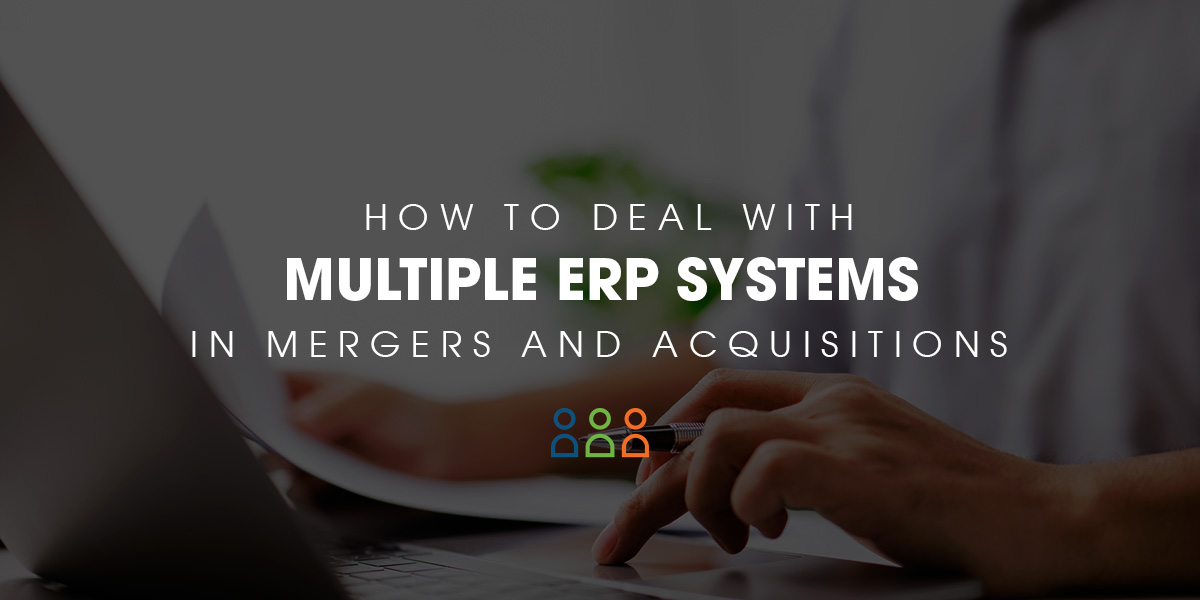
As a business owner, you want your company to grow. One way that many businesses experience sudden, valuable growth is through mergers and acquisitions. These are amazing business opportunities but come with some complexities you must navigate.
If your business uses an enterprise resource planning (ERP) system to stay productive, then there's a good chance you'll have two ERPs after the merger or acquisition is complete. In other words, a business acquisition can also be an ERP acquisition, and you need to know whether you'll keep the two ERPs separate or combine them into one.
With the right ERP strategy following a merger and acquisition, you can ensure your business keeps growing the right way.
When Does an ERP Consolidation Makes Sense in a Merger and Acquisition?
Some businesses are more suitable for an ERP consolidation strategy than others. Consider the following three steps to see if consolidation is right for your business.
1. Acknowledge the Impact of ERP Consolidation
Even the most comprehensive ERP integration strategy can have positive and negative effects you must weigh against each other. For instance, consolidation can help you streamline your operations to increase efficiency but could also halt your operations during the implementation phase. Greater efficiency may have plenty of benefits for the future of your business, but your employees may face a bit of a learning curve getting used to the consolidated ERP system.
Take time to thoughtfully analyze the pros and cons of ERP consolidation and how they will impact your business. If you find that the positives outweigh the negatives, you can confidently move forward in considering ERP implementation for a merger and acquisition.
2. Determine the Cost and Strategic Benefits of Your ERP Systems
Next, you should see if consolidating your two ERP systems will save you money or have other strategic benefits, like saving time or helping your company achieve further growth. Determine how much money you're spending keeping both ERP systems active. You may need to collaborate with your IT department or finance team to get the most accurate numbers.
Consider what would happen if your business transitioned from using several old systems to one newer, streamlined system. If you find that consolidating will give you a better return on investment (ROI), then doing so may be the right decision for your business.
3. Identify Business Benefits
The final step is seeing if consolidating ERP strategies for mergers and acquisitions will benefit your business as a whole. Find any pain points in your operations as they relate to having two ERP strategies. Will consolidation ease these pain points?
Reach out to ERP integration companies and ask for case studies and white papers showing statistical evidence of the benefits consolidation could give to your company. After seeing the numbers and considering the positive impact it could have on your business, you may find that ERP consolidation is the proper path moving forward.
What are some ERP Consolidation Challenges?

Even if you decide that ERP consolidation is right for you, you should still be aware of some of the challenges you might face. Here are five of the potential ERP integration challenges you might face when deciding to consolidate your business's ERP systems after a merger and acquisition:
- Choosing the right ERP system: The first challenge is finding the right ERP system for your consolidation purposes after a merger and acquisition. Choose one that fits your business model, financial needs and industry.
- Data migration: Moving the data from two ERP systems into one is much more complicated than clicking and dragging a file on your computer. Your IT teams will have to take the data from your old database and update it to meet the new system's requirements. They must import all this data to the new database, facing and fixing any potential issues they meet along the way.
- Work disruptions: There's a good chance you'll encounter some downtime when implementing your new ERP system. Even if the process is fast and easy, your employees will still need time to train and familiarize themselves with the new system. Many types of ERP integration systems exist, so choose one that includes learning materials and support.
- Employee enthusiasm: Change can be difficult for some people to accept, especially regarding your employees' workflow. Keep an open line of communication with your employees before and during the consolidation process, and explain that the changes will make their lives easier after the initial learning process.
- Financial costs: You'll have to spend money on your new ERP system. The process can get expensive depending on the complexity of your case. Besides upfront costs for your new system, you should also consider the costs of training your employees and implementing the new system into your business's processes.
Steps to Ensure a Smooth ERP Consolidation
Once you're ready to begin your ERP consolidation process, take measures to set yourself up for success. Here are some of the steps you can take to make the transition process as easy as possible:
- Clean and standardize your data: The whole process starts with your system. Take the time to delete outdated data that would be a waste of time to transition to the new system. You can also comb through your existing system and standardize the data types and formatting to make their transfer to a single data set simpler.
- Create an implementation plan: Make a plan to help guide the various steps of the implementation process. This can include a timeline of cleaning out your old system, setting up the new ERP, testing, training and getting customers ready for the change if necessary. Add buffer times to your implementation plan to allow for anything unexpected that might arise. You can even set aside time to reward your team for their hard work and flexibility during and after the transition.
- Set a date to start the transition: Once you have events mapped out, you can select a date that marks the completion of the transition.
- Ensure users and stakeholders are supportive: Train company leaders and get them excited about the new ERP system. Tout the benefits of the new system to get everyone on board.
- Communicate new workflows: One of the main reasons you're consolidating your ERP systems is to streamline your employees' workflow. Be sure to communicate these changes to help your employees adjust to the new system and take advantage of the greater efficiency of the new system.
Let The Vested Group Help With Your ERP Consolidation for Mergers and Acquisitions
The Vested Group is ready to help you consolidate your ERP systems after a merger and acquisition. We service a variety of industries, so we can give you the custom experience you're looking for in your company's sector of the market. Contact us today to take the next step toward streamlining your operations with a consolidated ERP system!






